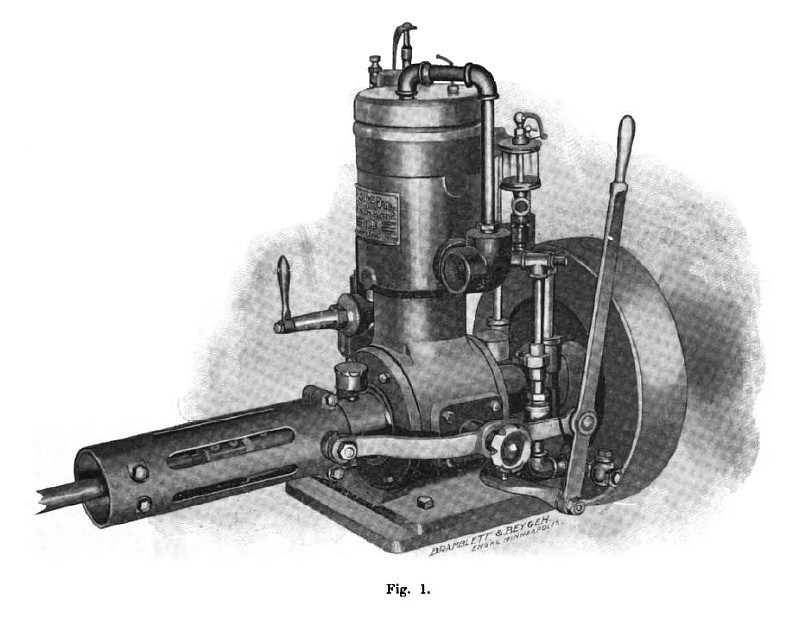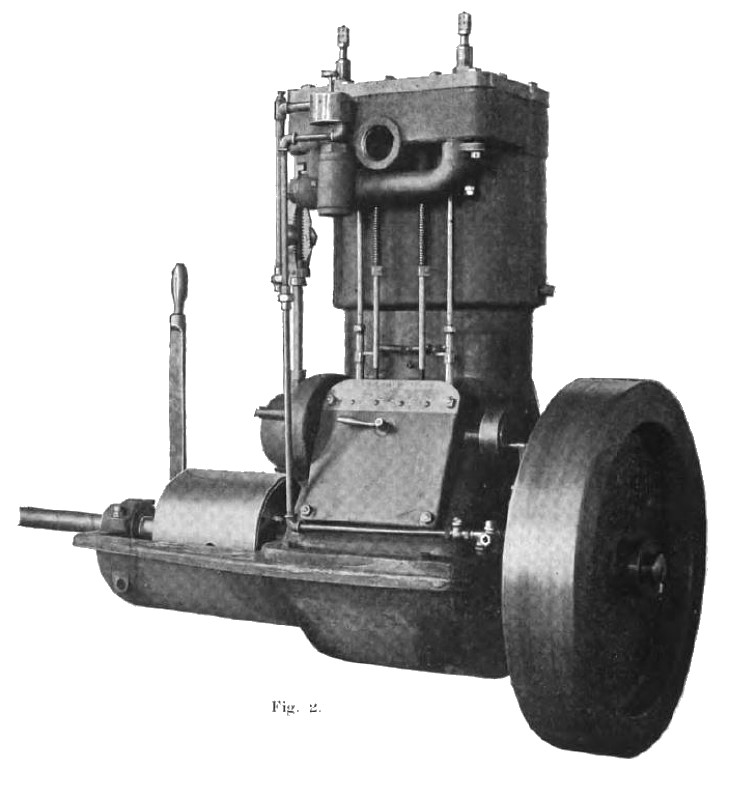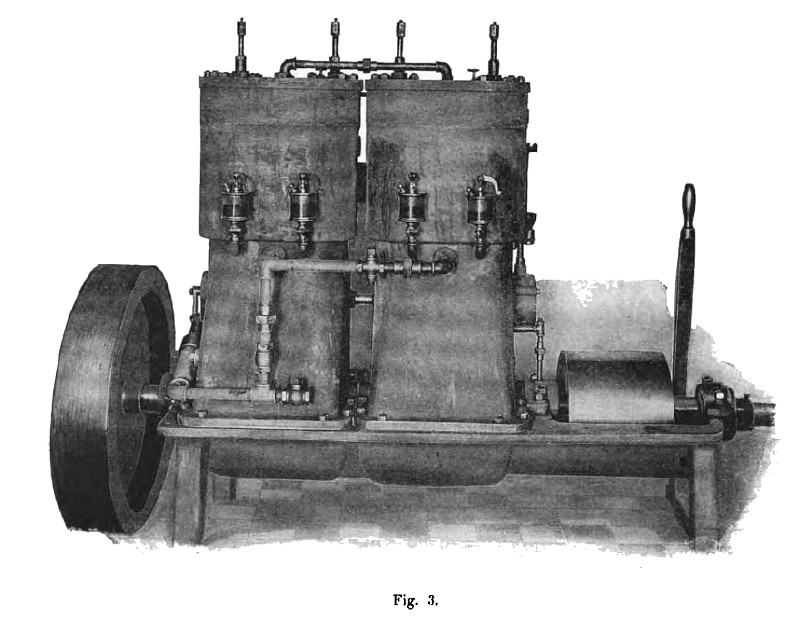|
Title: |
1901 Article-Globe Iron Works, 4 H. P. White Gasolene Engine |
|
Source: |
Gas Engine, V3, Feb 1901, pg. 49 |
|
Insert Date: |
5/20/2018 9:21:52 PM |
THE WHITE GASOLINE ENGINES
A four-cycle engine no heavier than a two-cycle would appear to be an impossibility, yet at least one of the engines to be described in this article goes the two-cycle even better than an even thing in weight. But more of this later. The “White” engine illustrated and described on this and the following pages is made by The Globe Iron Works Co., Minneapolis Minn. Although this company manufacture both marine and stationary engines, space will not permit us to describe but the one type, the marine engine, in this issue.
For the smaller sizes, the White engine is made in the two-cycle type, and this style is illustrated in Fig. 1, which shows the exhaust side of the four-horsepower size. On this side of the engine may be seen the lever for operating the reversible propeller as well as a portion of the piping. As is shown in the illustration, the outlet water passes into the exhaust-pipe, assisting in keeping it cool and in deadening the noise. Two pumps are employed on this engine, one for furnishing water to the jacket, and the other for lifting the fuel to a constant-level reservoir from whence the supply is taken by the engine. Contrary to the usual custom, the gasoline is not taken into the crankcase, but it enters the by-pass between the crankcase and the cylinder, being drawn in by the suction of the air-draft as it passes through. By this method the amount of fuel is in direct proportion to the air supply, as the throttle is located between the crankcase and the fuel inlet. The advantages claimed for this method are that an explosion in the crankcase is made impossible, and that the gasoline does not mix with the lubricating oil and dilute it, thus preventing the letter from being splashed into the cylinder with the air. The piston is supplied with a peculiar form of hood which is said to compel the fresh charge to pass the entire length of the cylinder and back again before it can reach the exhaust-port, thus reducing to a minimum the danger of a back explosion.
All White engines of powers above six-horsepower are built in the four-cycle type, the sizes ranging in seven steps from six to thirty-two horsepower. The engines of 8, 12 and 16-horsepower are built with two cylinders, while four-cylinder engines comprise 16-, 24 and 32-horsepower sizes.
The two-cylinder 16-horsepower engine is illustrated in Fig. 2. This engine is rated at 16-horsepower when running at 350 r. p. m. The base is 22½ by 44 inches; diameter of flywheel, 27 inches, and weight, 1,450 lb. Compared with one of the best-known two-cycle engines of the same horsepower, having the same number of cylinders, and running at 380 r. p. m., this engine is lighter by 50 lb. This engine also uses the constant-level fuel reservoir and suction feed as in the two-cycle engine, the reservoir appearing in the out just aft of the exhaust opening. In this engine and in the two-cycle is employed a peculiar type of the push-rod igniter, which gives a slight rubbing action at each contact, thus tending to keep the contact surfaces clean. This igniter is that commented upon under the head of Recent Patents in our last issue and is No. 664,110. Aft of the cylinders may be seen the gears which operate the governor. A governor, it may be said, is quite frequently placed upon a marine engine in these days. The engine is, as is usual, run constantly in one direction, and a solid propeller is used which is reversed by means of a clutch and gears.
The port side of the four-cylinder, 32-horsepower engine is shown in Fig. 3. With the exception of having four cylinders, this engine-is in other respects the same as the 16-horsepower. It runs at 300 r. p. m., has a base.22§‘by 62 inches, a flywheel 27 inches diameter, and the total weight is 2,700 lb. Comparing this weight with a two-cycle engine of equal power, we do not find a four-cylinder, two-cycle engine, but a thirty-horsepower, two-cylinder engine of this type running 300 r. p. m., weighs 3,000 lb., and another make under the same conditions weighs 2,600 lb., while a two-cycle, three-cylinder running at 340 r. p. m weighs 2,900 lb.
Whether the engine loses or gains in other respects by sacrificing weight it is not in our province to discuss, as this point is one for the selling agent. That this point is one which is discussed considerably is shown by the fact that one manufacturer is advertising his engine as the heaviest on the market. |
|
 1901 Globe Iron Works, 4 H. P. White Gasolene Engine
1901 Globe Iron Works, 4 H. P. White Gasolene Engine
 1901 Globe Iron Works, 16 H. P. White Gasolene Engine
1901 Globe Iron Works, 16 H. P. White Gasolene Engine
 1901 Globe Iron Works, 32 H. P. White Gasolene Engine
1901 Globe Iron Works, 32 H. P. White Gasolene Engine
|
|